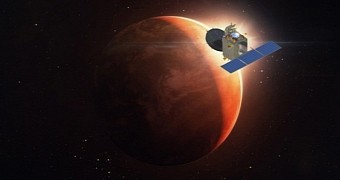Just hours ago, the Indian Space Research Organization announced to the world that its Mangalyaan spacecraft had not only reached Mars, but had also started orbiting it.
“What is red, is a planet and is the focus of my orbit?” the Indian Space Research Organization wrote in a Twitter post that took the online community by storm.
The spacecraft is said to have reached the Red Planet around 10:11 p.m. EDT on Tuesday, September 23 (7:41 a.m. on Wednesday, September 24, by Indian Standard Time), Space informs.
After getting close to the planet, the Indian probe, whose official name is the Mars Orbiter Mission (MOM, for short), fired up its engines and placed itself in the right spot to be captured by the local gravitational pull.
Once caught in by the Red Planet's gravity, the spacecraft started orbiting it. This first mission that the probe had to execute took about 24 minutes to complete. The process of having a probe get close enough to a planet to be caught in its gravitational pull is known as orbital insertion.
So, what's all the fuss about?
If you've been paying attention to the news, you might have heard that, just a few days ago, one other probe, i.e. NASA's MAVEN spacecraft, reached Mars. This space traveler not only reached its destination faster, but is also fancier than Mangalyaan.
Why is it then that everybody is jumping up and down with joy at the news that the Indian Space Research Organization managed to put a spacecraft in Mars' orbit? Well, there are several reasons.
First off, the success of this mission makes the Organization the fourth entity to have until now successfully planted a probe in Mars' gravitational field. The other three are the US, The European Space Agency, and the former Soviet Union.
What's more, this spacecraft represents the first successful Mars mission to have until now been launched by an Asian nation. So, yes, the news about Mangalyaan's placing itself in Mars' orbit is a pretty big deal.
As Indian-born planetary scientist Amitabha Ghosh explained in a recent interview with the press, “It is a validation that Indian research and development has come of age.” Otherwise put, this mission proves that the Indian Space Research Organization has what it takes to play with the big guys.
The spacecraft's working agenda
Information shared with the public says that Mangalyaan packs a total of 5 instruments, whose combined weight is one of about 15 kilograms (approximately 33 pounds). The probe is expected to use these instruments to study Mars' landscapes and makeup. The spacecraft will also have a look at the planet's atmosphere.
It is understood that this spacecraft will circle the Red Planet on a highly elliptical, 77-hour orbit. At times, it will get as close as 227 miles (365 kilometers) from its target. When at the farthest point of the orbit, it will sit at a distance of about 49,710 miles (80,000 kilometers) from Mars.
Scientists with the Indian Space Research Organization say that the probe currently has about 36 kilograms (nearly 80 pounds) of fuel left onboard. This should be enough to keep it up and running for about 6 months to come.

 14 DAY TRIAL //
14 DAY TRIAL //